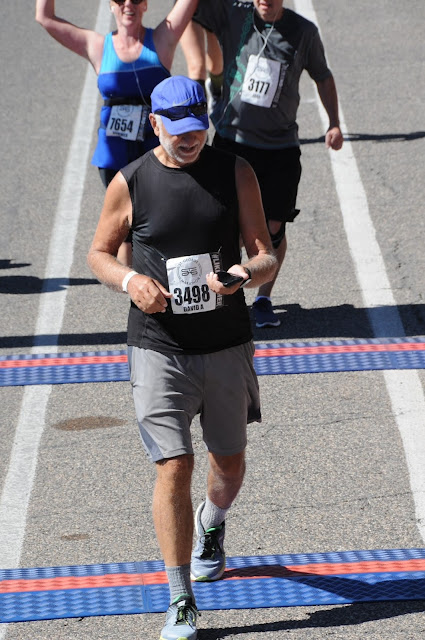Passages describing running are common in ancient Greek and Roman literature. Footraces were very popular in the eastern Roman empire. The running track (called a stadion) was 180 meters long and 27 meters wide. The spectators would stand or sit along the earthen embankment that flanked the track (only rarely were there seats). The crowds would cheer on the runners, whose desire to look good in front of others spurred them on to even greater efforts. "At the sound of the signal they were off," writes Virgil (Aeneid 5.315), "leaving the starting line and tearing over the course."
In a comment about the writing style of Herodotus, Aristotle has this to say about the race itself (Rhetoric 3.9.2):
"This is the exposition of the history of Herodotus of Thurii." It was formerly used by all, but now is used only by a few. By a continuous style I mean that which has no end in itself and only stops when the sense is complete. It is unpleasant, because it is endless, for all wish to have the end in sight. That explains why runners, just when they have reached the goal, lose their breath and strength, whereas before, when the end is in sight, they show no signs of fatigue.
Aristotle is talking about what in rhetoric is called a period. A period is a sentence that draws a number of different ideas into an integrated whole. The Greek word periodos conveys "an image drawn from paths which go round and are in a circle" (Demetrius, On Style 10). Recently on this blog, I looked at Heb. 4:12-13, which begins and ends with the Greek word logos. This period starts out with God's "word" of revelation and concludes with our "word" of explanation, as we must all render "account" (logos) before God on the Day of Judgment. Of course, the most famous periodic sentence in Hebrews is its opening prologue, 1:1-4, which I have studied in detail here. (It is an amazing passage.)
As a runner, what's interesting to me about Aristotle's quote is when he says that it is only when runners have reached the finish line do they "lose their breath and strength." Until then, their endurance carries them through their fatigue. Modern science seems to confirm Aristotle's observation.
Dr. Timothy Noakes is one of the world's leading sports physiologists. He has studied and written about practically every aspect of running. He observed that in a run of any distance, fatigue occurs around two-thirds of the way into the run. This pattern occurs whether you are going out for a 10 mile run or a 26.2 mile marathon. When you begin your run, you are full of energy. About halfway through, you being to feel tired. About two-thirds of the way through the distance, you begin to have to work really hard to continue. This pattern repeats itself regardless of the distance you are trying to run. On this basis, Dr. Noakes argued that fatigue is more a mental than a physical phenomenon. Whether you are running 5 miles or 20 miles, you will have a similar level of mental fatigue. I have personally experienced this in every race I've run, from 5Ks to 31-mile ultramarathons. It is only in the final third of the race that you really have to push and put in the work.
It is endurance, then, and not speed, that gets us to the finish line. And what is true of the sport of running is true about life. Both sports and life push us to our limitations. Our motivation comes from the way Jesus "endured from sinners such opposition against himself" (Heb. 12:3). Our Lord remained faithful despite suffering, and so can we, as we "look unto Jesus, the Pacesetter and Completer of faith" (12:2).
 |
| At the finish of the St. George (Utah) Marathon. A new PR! |
Fellow runners in the race of life, let's not fall short of the goal. Let us visualize our success, yes, but also the obstacles we will face, and how we can surmount them. This is the only way to prepare for the running (and life) challenges ahead in 2022.
 |
| Before the start of the "10K on the Runway" in Greensboro, NC. |